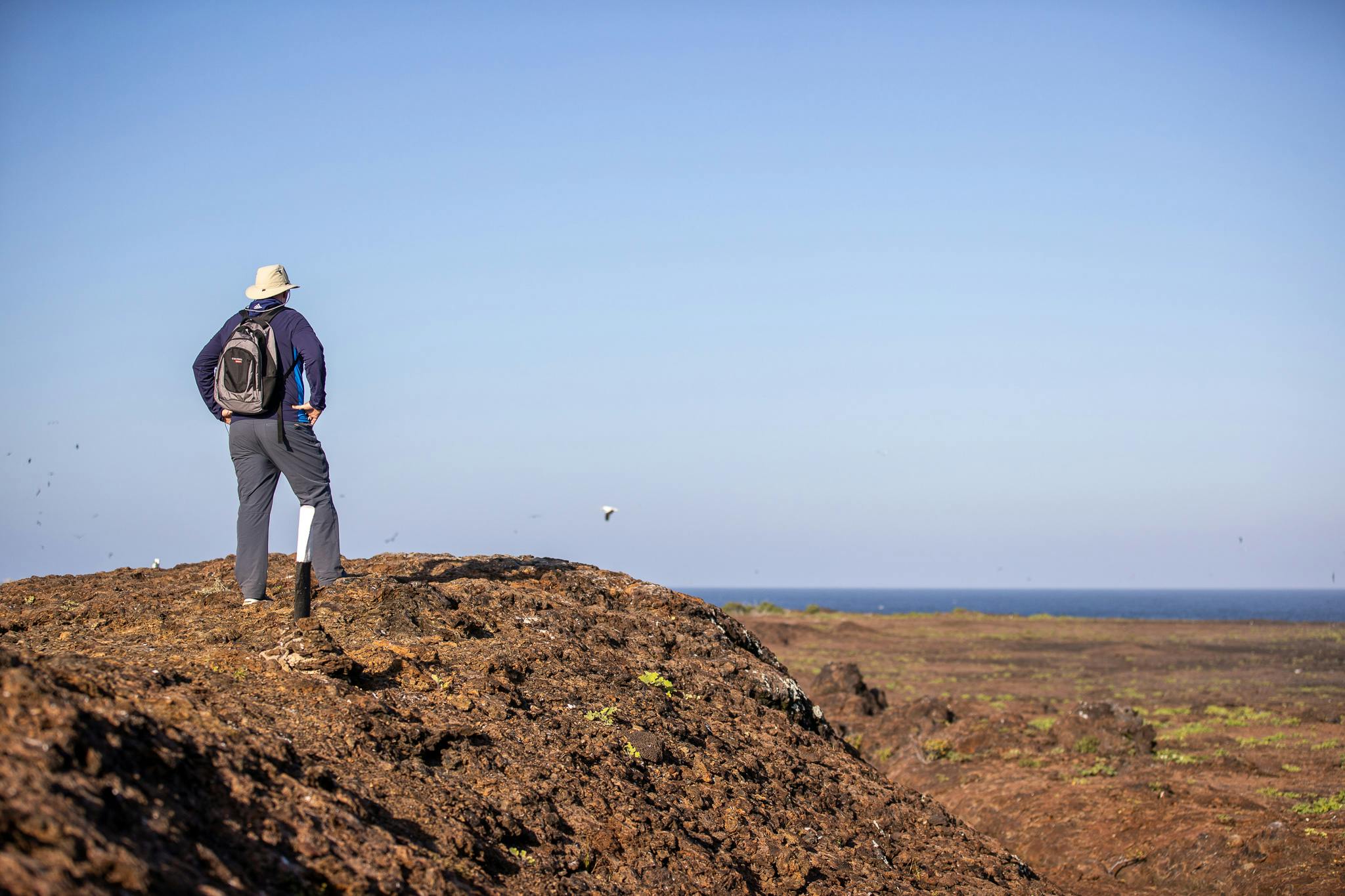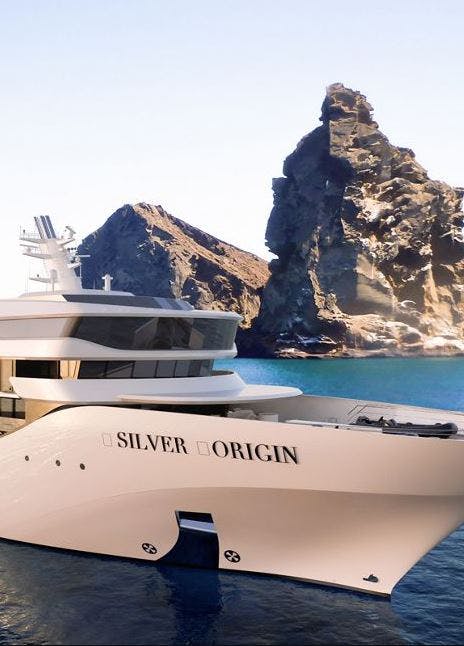Just Back From…Galápagos Islands on Silver Origin
Peter Shanks, Silversea’s Managing Director – UK, Ireland, Middle East and Africa, has traveled to just about every possible destination — except Galapagos. Recently returned from a trip to the Ecuadorian islands, Shanks traveled to Galápagos in April, at the end of the rainy season, and shares his experiences, both onboard Silver Origin and off. He traveled with his wife, Lesley.
The last time I was so moved I cried was at the wedding of my eldest daughter, as I walked her up the aisle. Until arriving at Silver Origin, where, stepping onto Basecamp, Silver Origin’s welcoming hall, the impact of this incredible place moved me to tears again. I’ve heard that the Galápagos is a “trip of a lifetime” from friends and colleagues and it’s taken me almost 64 years to get here. What had I been waiting for?
“On our cruise around Galápagos was three life changing experiences every day: one nature, one snorkeling, one the vistas. You know when something incredible happens an involuntary noise comes out of your body? it was a burst of happiness.”
–Peter Shanks
My two-week cruise around the Galápagos Islands, was an amazing journey, literally and figuratively, and I wanted to share it with you. We boarded Silver Origin off San Cristóbal and traveled two itineraries, a pair of seven-night runs. You can still absolutely get the magic in one week, and for the longer cruise there’s only one day when you overlap ports, visiting the giant tortoises at Montemar Tortoise Reserve on Santa Cruz.
First stop: Quito, Ecuador
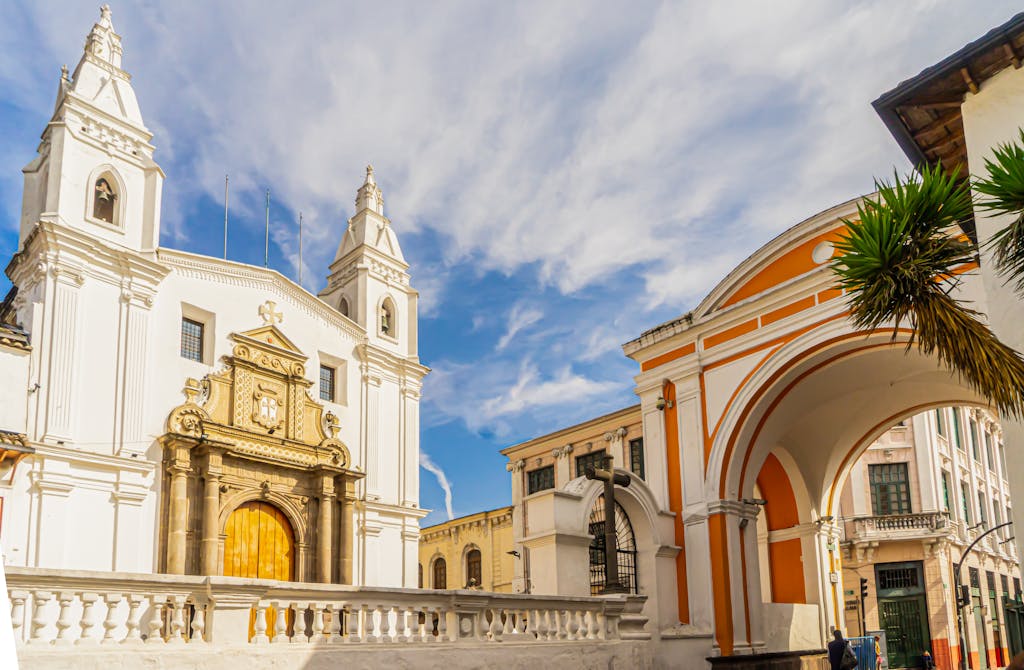
KLM was a terrific flight option. It was a short hop from London to Amsterdam and an excellent flight to Quito where some 11 hours later we arrived into Ecuador. We added a night on to the pre-cruise overnight in Quito, curious about making discoveries there — and also to rest up for the experience-intense action we were looking forward to around the islands of the Galápagos. We stayed at the Casa Gangatena in the very heart of Quito’s old town. It’s an ancient colonial house converted into a hotel with just 32 rooms, and is right in the heart of Quito. Not long after settling in we watched from the roof terrace as the sun went down, surrounded by a confusing array of so many churches who all seem to have a different time with church bells sounding a random 10 minutes either side of the hour.
Quito Old Town is a truly foreign and cultural experience. We really only had the one full day to explore before our onward journey to Galápagos and we felt it was important to explore Ecuador’s culture. The biggest surprise? We wound up becoming immersed in Spanish culture instead. That’s because, like many South American countries, Ecuador was invaded by the Spanish, who destroyed its indigenous churches and temples to build their own on top.
Our first stop was the Casa del Aldabra Museum, a converted Spanish colonial house. The many artefacts brought to life aspects of ancient Ecuadorian cultures, their relationship with ancestors and religious ideals and rituals. I am not brave enough to include some of the more risqué figures – save to say that genitalia seemed to play a larger than life role in ancient times. It was a great introduction to Ecuador.
Talking of culture – a young woman at the museum offered to talk us through what to expect. She spoke beautiful English and I asked where she had learned it so well. ‘Pop culture’ was her answer — and that reminded me of today’s influence of films, TV, music and social media. That is where she picked up her impressive language skills.
It’s rather sad that in Quito there is little or no evidence of the indigenous people and culture of Ecuador. When the Spanish came they collected the gold and built their own churches – often on top of where original and ancient sites had stood. And there must have been a sense of ‘my church is bigger than your church’. When we looked around La Iglesia de la Compania de Jesus, we felt a need to be impressed by the amount of gold that literally covers every inch of the church. But we had a different feeling – one of how at odds all this opulent wealth is to the lines of local people each morning queuing up in the square at the Basilica and Convent of San Francisco to provide them with hot food.
Lunch was a local dish of fried pork and salad at the famous Vista Hermosa rooftop restaurant – washed down with a chilled Corona with views of the city all around us – that certainly did the trick.
A note about our choice of accommodations. All guests heading to Silver Origin have two choices of hotel. The included choice is what we describe as “simply hotel,” the J.W. Marriott. We opted to upgrade to Casa Gangatena because we wanted to be in the heart of the old town rather than the modern city.
Then onwards the next morning with an early flight to San Cristobal via Guayaquil. Interestingly, there are no direct flights from Quito to Galápagos from Quito because there is no way to refuel in the islands. Our flight was about 2 1/2 hours with a brief stop in Guayaquil.
Another note on travel logistics: To get into Ecuador from the U.K. you fill out a pretty simple form. There are more forms to enter Galápagos (officials want to make sure you come — and depart) and it was nice that a Silversea representative, who joined as at the airport, assisted us at check in (and filling out the forms) and even flew to the islands with us. We were then met by the expedition team who were waiting for us at the airport in San Cristobal.
First lesson learned: The 48 hours in Quito works, breaks up the long journey from the U.K. (it’s a six hour time difference for us — though only one hour ahead of New York) It allows a little insight of Ecuadorian history and culture — and yet — it’s a staging post to the real prize to come.
Being there
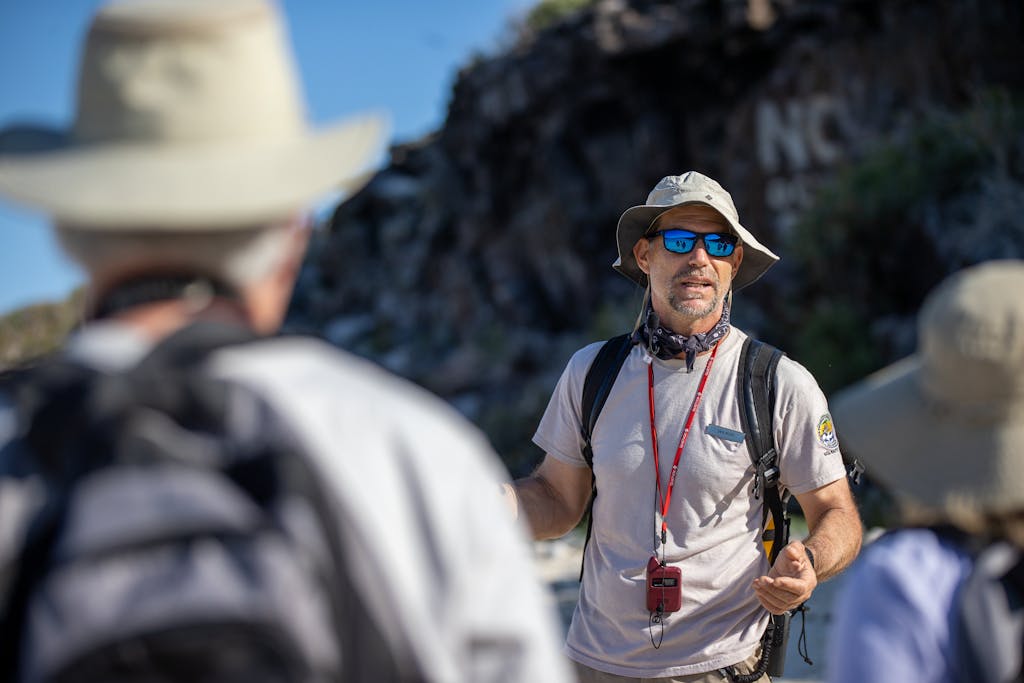
The sight of the Silversea expedition team as we arrived in San Cristobal, with the somewhat old but effective buses waiting to transport us on the 10 minute journey down to the waiting zodiacs in the harbor, was something to behold. The expedition team looked right out of Indiana Jones and you could already feel we were in experienced hands. You don’t have to wait long – once down at the port as we boarded the zodiacs we were surrounded by a welcome party of Sea Lions and by Blue Footed Boobies dive bombing the harbor for their lunch.
And there she was – gleaming in the sunshine – Silver Origin. Arriving by zodiac and being helped up the aft landing stage into Basecamp – being handed a glass of sparkling wine and a Silversea smile – well that was when I nearly did that crying thing again. After a long journey and at the start of our ‘trip of a lifetime’ – we had arrived at one of the most incredible places in the world, full of anticipation of what lay ahead for the next two weeks.
There’s no hanging about. On the 100-passenger Silver Origin, we were all aboard and shortly after arrival, and having completed the safety drill, we set sail for Kicker Rock. The boot-shaped rock (hence the name) is one of the most iconic sites in Galápagos and the positioning and propulsion of Silver Origin kept us remarkably close. It was 6 p.m. – time for an Ecuadorian Club Prime at the deck 7 bar as the sun went down on the equator and our Galápagos adventure had begun.
Truly, the Wildlife Here is Remarkable
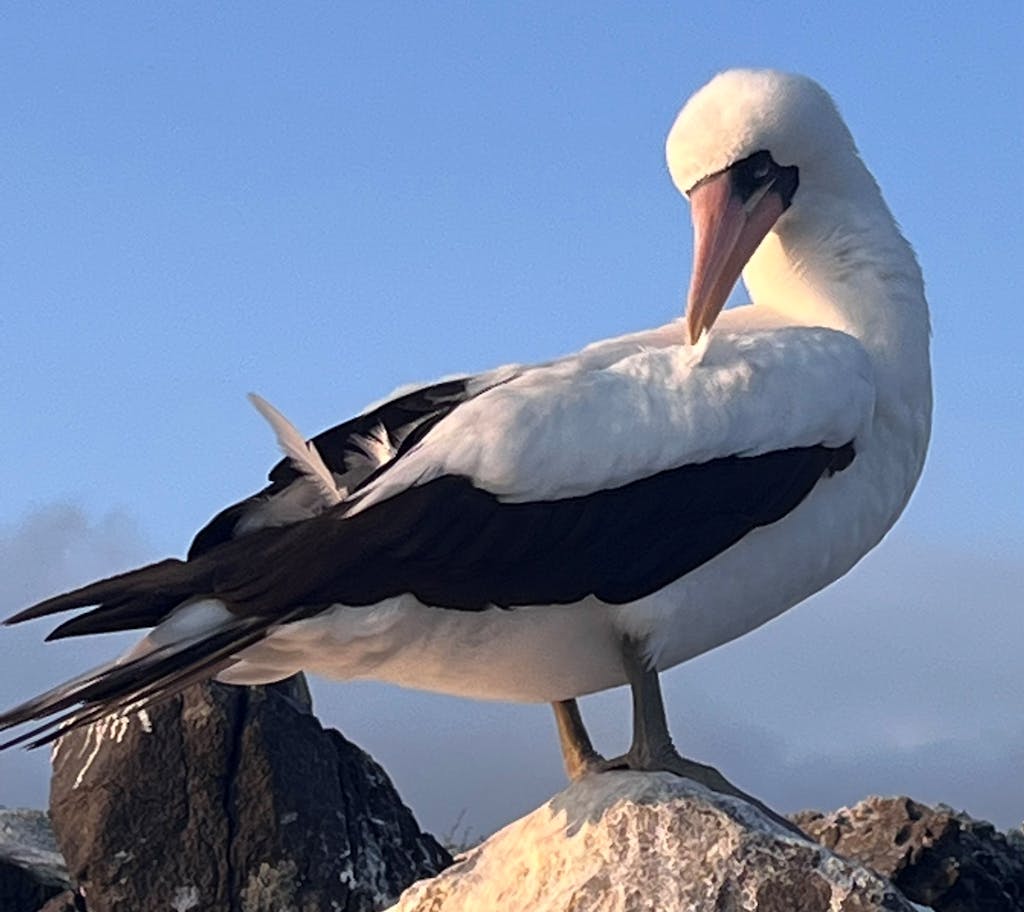
What’s different about Galápagos is not that you discover one new species of bird or animal at a time. It’s all around you all of the time. I am not a twitcher by any means – but the birdlife is incredible. I had of course heard a lot about the Blue-Footed Boobies – and their blue beak and feet are every bit as blue as I had hoped. They are brilliant aviators and excellent anglers. On several occasions whilst snorkelling one would dive right next to me, going several metres down to retrieve their breakfast or lunch. But I discovered there is more than one Boobie – I met the Red-Footed Boobie and the larger white Nazca Boobie.
The other species you will see a lot of is the Frigate Bird. They soar so well and look like a flashback to the dinosaur days. The males have a wonderful red balloon that comes out below their beak as part of their mating ritual.
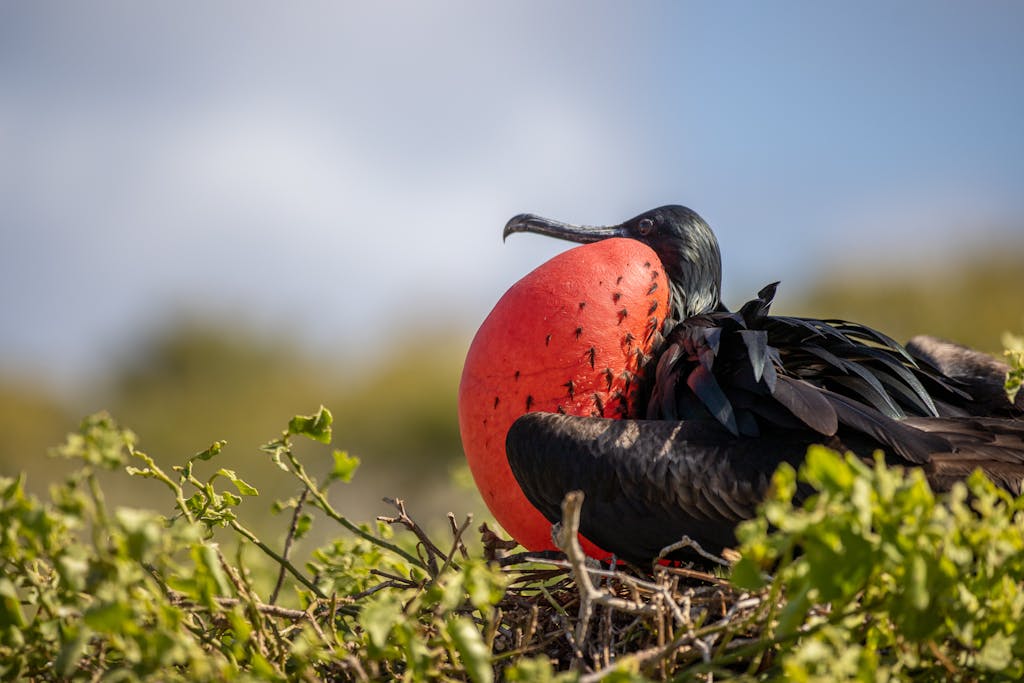
And then of course the famous Darwin Finches are everywhere. We saw several different species. The Galápagos Mocking Birds sing beautifully, the doves are graceful, the Herons plentiful. We even caught a rare sighting of the famous Galápagos Owl – the only owl that hunts during the day. On Genovesa Island we went on a nature hike that took us right into the nesting area for boobies and frigates. The boobies were very busy gardening for twigs and branches to build their nests. The frigates had a different approach – they let the boobies do all the work then swooped down in mid-flight to grab the twigs and branches to build their own nests. We saw hundreds of nests, eggs, youngsters and a real demonstration of the ongoing breeding and fertile nature of Galapagos.
When you first come across marine iguanas you don’t quite know what to expect. We first saw them as our zodiac landed on Fernandina. There were hundreds! They were all over each other and, depending on the time of day, they face toward the sun, especially in the mornings, when they were cold. Later, when it gets warm, they turn around.
We also saw many Land Iguanas – they are a lot bigger. We were in Galápagos at the beginning of the wet season. It was April, and things were remarkably greener than you would see for the rest of the year. Definitely, the Land Iguanas had plenty to eat and looked very full and contented. They are such a flashback as they look so dinosaur-like with an amazing yellow colour. They stand regally and are in control of their environment and we often had to stand still as they were wandering down the path – taking no notice of us as they ambled past.
Birds and animals are everywhere, together, and that’s why Galápagos is so overwhelming. There are sea lions, blue-footed boobies, frigate birds. A hawk flies over you. It’s not like a safari when you’re spending six hours to get a peek at a giraffe.
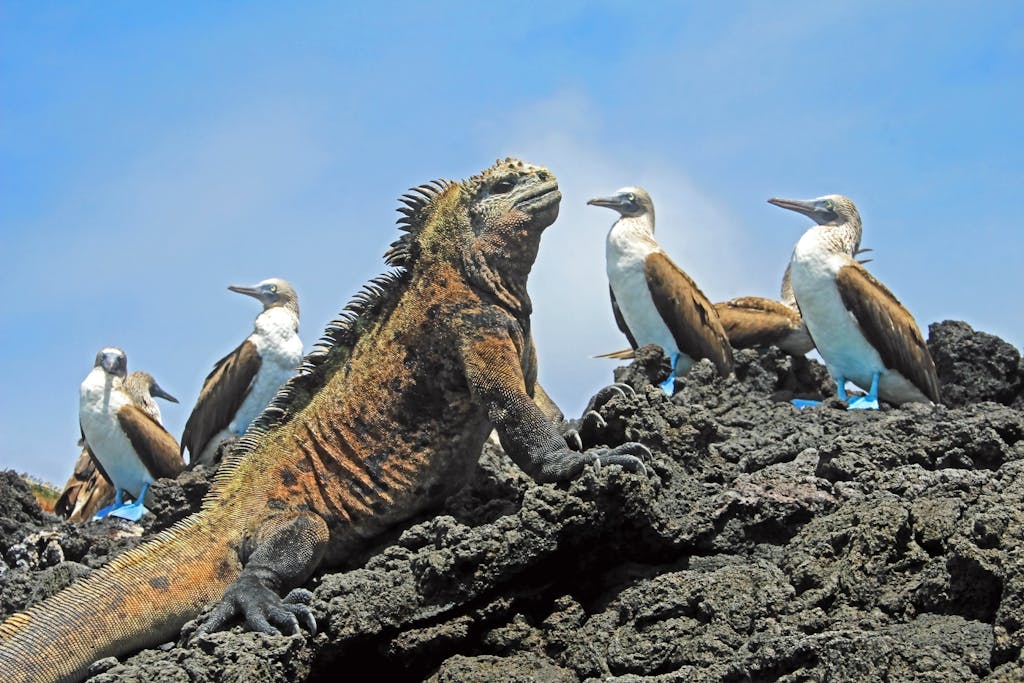
The two hour nature walk on Fernandina was a highlight – it was like being transported into a David Attenborough documentary. There were so many different species thriving in close proximity, in harmony. That would be a rare find elsewhere and again, they were just everywhere. I’ve never seen anything like it.
We watched a father sea lion protect his wife and child by barking at and chasing off some younger males. We saw eagle ray fins out in the bay and sea turtles crawling out of the sea to rest in the sun. And then there was a hubbub – even our guide was excited: About 50 feet in front of us was a Galápagos Hawk and it was eating a recent catch of a marine guana. The hawk is not seen on many islands and it is right at the very top of the food tree. We stood transfixed as the hawk looked up at us – and decided to carry on devouring its prey. As we finished our two hour walk, and as the sun began to set as we boarded the zodiacs, that was my most emotional and special couple of hours in Galápagos.
At the end of the walk we stood in silence by a beautiful lagoon taking in all around us as the sun started to set. To see all that life – and death – and to see it all so close up and with so many species living in such harmony was an experience I shall never forget.

And how could I nearly forget to mention the giant tortoises. We went to the Montemar Tortoise Reserve on Santa Cruz. They are enormous; a male weighs up to 600 pounds. It was a beautiful reserve up in the highlands and very green. The tortoises can go wherever and whenever they like and everybody is in awe and respectful of them. They were nearly extinct at some stage in Galápagos but are now thriving on several of the islands which is terrific.
And if that is not enough wildlife on land, another highlight came on our last nature hike on the most southerly island of Espanola – the nesting pace for the famed and elusive albatross. We trekked across a rocky path and came across our first albatross actually sitting on the path as we passed by. That was exciting enough but moments later we were amongst hundreds of albatross – some sitting on nests, some flirting with potential partners and many soaring effortlessly above the impressive sea cliffs.
They are glorious birds – with a wingspan of some eight feet. We sat on the cliff edge watching the lively sea crashing against the cliffs several hundred feet below us – the air was full of soaring albatross, boobies and gulls whilst at the same time we were surrounded by marine iguanas. This was definitely an expedition – not least as on return to the beach we had to time our dash across the rocks to avoid the surf and jump into the zodiacs back to the ship as the sun went down.
Life at sea

Shark! On hearing that our first instinct would normally be to freeze in terror or be reminded of Jaws. Whilst deep water snorkeling in Galápagos and hearing the word ‘shark’ then it’s a case of where – can I get closer – let me see. We had seen many smaller sharks in the protected mangroves and surfing for fish in the waves close to the beach. But on this snorkel we found ourselves floating above 10 or more White Tipped Sharks – each about 6 foot long. They are beautiful creatures and looked very calm as they lurked below us.
We saw so many different fish, often swimming in large schools and taking no interest or changing direction as we swam past them. Our expedition guides led us through each snorkel – and it’s so well organised. On arrival every guest receives their dive bag – with previously sized wetsuits, flippers and snorkel. After each snorkel outing everything is cleaned and then stored down on the boarding platform by Basecamp.
On the first day there is a beach trip where all the kit can be tried out and then on most days there is a deep water snorkel. We go out by zodiac ready to snorkel led by a guide. We then prepare together and launch into the ocean, normally alongside a reef or cliff and the guide leads us through 45-60 minutes of exploration. We snorkelled with rays, sharks, penguins and sea turtles.
I had a magical Galápagos moment when surrounded by six or seven sea lions that played with me for a few minutes including a rather large male who swam right up to me, released a bubble right in front of me, and then popped it with his nose. I’d heard that in Galápagos it’s the sea lions that always steal the show and I had my own memorable close encounter with them.
At the end of the dive we would return to basecamp – with towels and hot tea waiting as we all swapped stories as to who saw what and how big it was. Only on Silversea are you welcomed back onto the landing platform by our butlers with towels, robes and a glass of sparkling wine. Guests can snorkel as often as they like and I managed it most days. I noticed that whether you were snorkeling novice or expert, the guides put everybody at ease and pointed out the many different species underwater.
Silver Origin

Our ship, which debuted in 2021, is designed for Galápagos and it does not take long for it to feel like home. Partly that’s because it’s the first ship Silversea have designed specifically for the destination – and it really works. Basecamp is where we gather, then we’re led out to a briefing on the aft deck, and walk right onto the Zodiac. Physically, it’s designed to make that whole experience of gettting on and off the ship so seamless.
As our home for the two week cruise, there were favorite aspects. I loved the view from Deck 7, the sundeck, which is completely open (except for railings of course) for 360 degree views that change three times a day. The top open Deck 7 is exactly that, with both the outdoor Grill and Bar forward and relaxing deck aft open to the incredible views. Lunch on Deck 7 is a highlight, a chance for everybody to chat through the incredible sights of the morning. Dinner at the Grill includes the optional ‘Hot Rocks’ experience as well as other choices – popular but no problem getting a reservation. The Observation Lounge right at the front of Deck 7 is a lovely quiet space with panoramic windows over the bow, comfy chairs and many books on the history, geology and wildlife of Galápagos. Up above that is the star-gazing area where after a few minutes to adjust our eyes we could clearly see the milky-way each evening.
One tip – after a busy nature walk, a deep water snorkel, or as the sun goes down – the aft Jacuzzi is just the job. The sunsets here on the equator are spectacular – and coincide with “Beer-O-Clock” at 6 p.m., a chance to reflect on each incredible day in Galápagos.
What’s Silver Origin like?

Suites are located on decks 5 and 6 and have floor to ceiling glass. The majority are Verandah Suites and jolly nice they are too, spacious, relaxing and everything you need in typical Silversea luxury. On Deck 5 they come with standard balconies and on Deck 6 with Horizon balconies which we really liked in our suite. With a Horizon balcony the suite feels larger as it goes tight to the edge with floor to ceiling glass, at the push of a button the top half slides down so your suite is open to the elements. The larger suites are to the aft and as you would expect are very spacious and special. But we found our Verandah Suite was perfect – as was our butler.
Also on Deck 6 is the small but adequate Fitness room as well as the Spa and Salon – relaxing massages after all the exertions seemed to be very popular. I was happy with all the exertions of the day – and my relaxation came with a cold beer, but my wife loved her attentive deep tissue massage at the end of a busy day.
Deck 4 has the main restaurant and the Explorer Lounge. The restaurant is spacious and open for breakfast, lunch and dinner. You must try the casuella, a bowl of fresh fish, a lunch staple — prawns, lobster, tuna and avocado. The Galápagos Slipper Lobster is very tender and you could have it as ceviche, surf and turf (with of course Ecuadorian beef). One day we had suckling pig … pretty much all the produce, meat, and seafood comes from Galpagos or Ecuador.
The wines too were lovely, hailing from Chile, Peru and Ecuador; we loved the Chilean malbec.
Moving on, the Exploration Lounge is right at the heart of the Silver Origin experience. It’s a quiet relaxing area during the day with coffee always on hand. Each evening we would all gather at 6:45 p.m., starting with a drink, a brief recap of the highlight of the day, a really interesting 30 minute lecture from one of the Expedition Team – and then a briefing as to what lay ahead for us on the following day. We learned so much from the lectures on the history, geology and wildlife of Galápagos. That was followed by dinner from 7:30 p.m.
Lastly down to deck 3 and Basecamp. That is also a hubbub of activity. As well as the informal reception area it is where we would all gather prior to each adventure. We were split into Green and Blue group, all very efficient, and we were led out in small groups to the landing stage, briefed by our guide and then safely loaded onto the zodiacs. In port, Silver Origin is always at anchor, always at sea so zodiacs become a way of life. The crew and expedition guides are very safety conscious – and we all very quickly learned the zodiac protocols and ease of getting on and off.
Here’s Why the Expedition Team Makes This an Experience to Remember
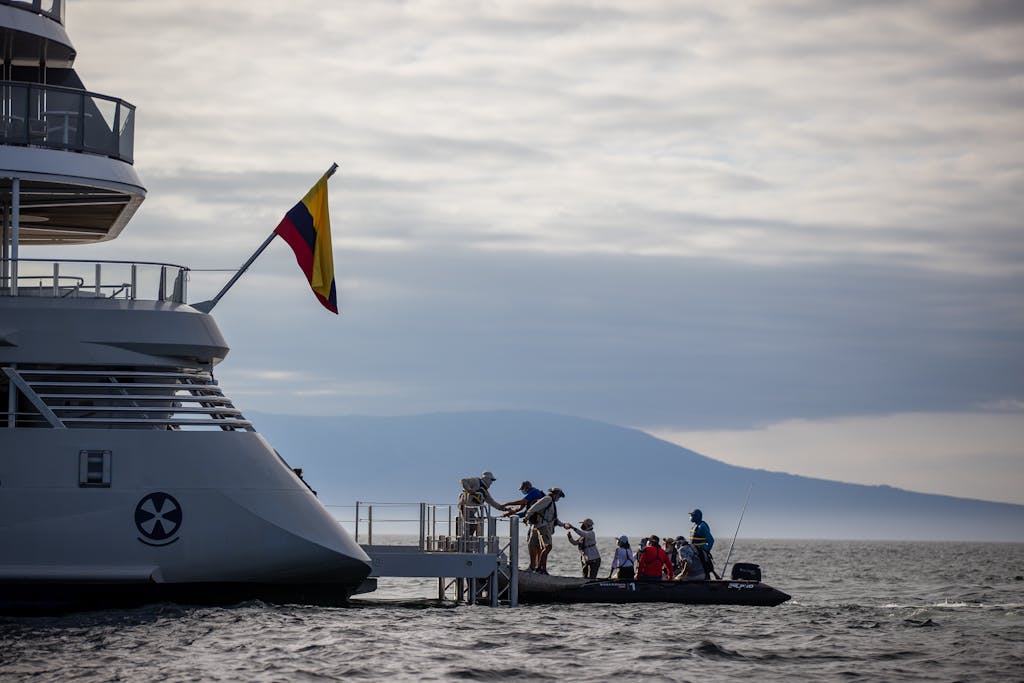
The expedition team deserves a very special mention and is right at the heart of the experience. They are trained in every aspect of Galápagos and are, variouosly, experts in nature, geology and wildlife. Many, but not all, are from Galápagos. We got to know them very well because they are with you at every moment ashore, snorkeling or on the zodiacs constantly identify the vast array of things around you. They also conduct lectures in their area of expertise each evening before dinner and are an integral part of the Silversea expedition experience.
Essentially life with Silversea in Galápagos in made up of three life-changing experiences each day – an early start but leaving you enthralled and quite emotional and reflective at the end of each day. Each day the ship will position at two different locations and sail to the second destination during lunch.
Reflections

A cruise on Silver Origin around the islands of Galápagos makes for a busy holiday packed with so many incredible sights and experiences. There is time each day to relax, and yet in Galápagos it’s best to get out to see and soak up as much as you can. The hikes and walks are typically for two hours and during each evening briefing members of the expedition team will describe how challenging each one is.
Once ashore you can grab a walking pole if you need – we did all the walks and all the snorkels as did most guests. The hikes do not cover long distances as most of the time is spent experiencing and hearing about the many sights and species around you. One thing you do need to be careful of is stepping on a marine Iguana or navigating your way past snoozing sea lions, all part of the experience.
It’s impossible to describe everything. The other fascinating aspect is the source of and volcanic nature of Galápagos over millions of years. So I will leave that, and the really interesting story of Darwin, for you to discover when you get there – and trust me you really should get there.
My advice? At the end of each day it’s good to take a quiet moment to soak up just what you have seen. For us, there were some very special moments. Swimming with playful sea lions and inquisitive penguins, coming face to face with an albatross, standing on a vast lava flow and you just have to love the Blue-Footed Boobies. The most overwhelming thing is the scale and variety of so many incredible species – and that all are living in harmony, alongside and respectful of each other.
It’s quite remarkable and an example to humble us humans.



